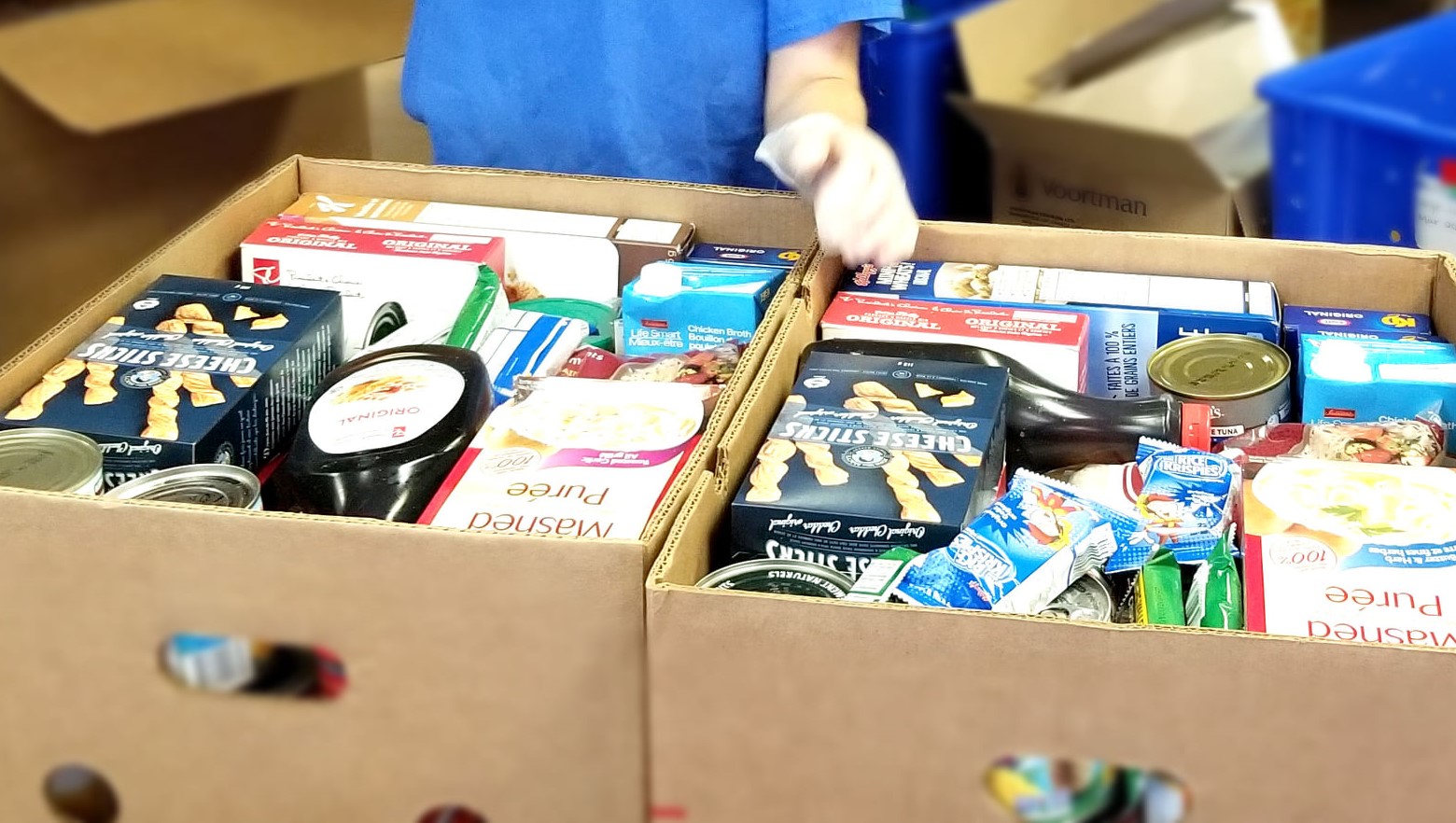By Rebecca Gruszka, Local Journalism Initiative Reporter
When the weather starts to turn and the dark sets in early, bright lights outline houses and Spencer Smith Park has an amazing light display. The holidays bring warmth and joy to the community. For some citizens, though, food insecurity is a cold reality they have to live with every day, but even more keenly felt during the holiday season. The Ontario Hunger Report by Feed Ontario highlights that food bank use is at a crisis level. Two in five people visiting a food bank between April 1, 2022, and March 31, 2023, were new to using food banks and 1 in 19 Ontarians now rely on a food bank, a 41% increase over 2019–20.
Similarly, the Burlington Food Bank has seen an increase in use as the needs of the community have risen. The 2022/2023 Burlington Hunger Report states that the total number of visits to the food bank increased by 42% from 2020 to 2022, slightly higher than the provincial number of a 36% increase over 2021 to 2022. In Burlington, there were over 20,000 visits in 2022 alone. They also saw an increase in daily visits: pre-pandemic, they would see twelve families, a day but now can see upwards of 35 families a day. Who is accessing the food bank? Burlington Food Bank says there has been an increase in seniors using the food bank as the cost of food keeps rising. Feed Ontario reported the same for the province: the rate of seniors visiting food banks across the province has nearly doubled compared to pre-pandemic levels.
During the pandemic, the Burlington Food Bank started delivering food to those in need. This change saw an increase in people seeking help now that it was accessible to them, highlighting the fact that there were people within the community who had not been eating enough — who knows for how long — but could not travel to the food bank to remedy their situation.
With the uncertainty of the job market, new Canadians are using the food bank for longer than before. The Burlington Hunger Report states that 1 in 7 people who use a food bank are employed, higher than the provincial statistics: the Ontario Hunger Report states that 1 in 6 clients are employed, marking an 82% increase from 2016–2017 and a 37% increase over 2021–2022.
Sadly, children 18 and under make up the largest group served by the Burlington Food Bank. As the Hunger Report notes, “A lack of food can impact not just a child’s physical development but also their intellectual development, mental health, social development, and education.” Last year, the food bank was able to give almost 5000 school snacks to families dealing with food insecurity.
Community member Wanda C. has been donating to her local food banks for the last seven years. She, too, has seen an increase in young people, families, and seniors accessing the food bank. Wanda shares that she started donating when she noticed the increasing needs of her community. She has now had years of making donations to various food banks, humane societies, toy drives, and other charities, and also volunteers her time, another way to support our fellow community members.
Christina Mulder, manager of the Burlington Food Bank, shared that the most common items clients ask for include turkeys, hams, hygiene products, coffee/tea, sugar, cooking oil, canned soup, canned fruit, and canned vegetables; the most in-demand food items are meat (halal and non-halal) and dairy products. Monetary donations go a long way by allowing staff to purchase in-demand items when stock is low. In Wanda’s experience, people also appreciate condiments, baby items like diapers, baby food, and pet food. She also tries to donate items like cookies, chips, and chocolate.
The Burlington Food Bank shares that the most important thing citizens can do is educate themselves about food insecurity in Burlington and share it with people they know. Next, they encourage becoming an advocate by letting other people about the work the food bank does. They can volunteer, run a food drive event, and donate. Don’t have time to run donations to a food drive? Monthly monetary donations can be set up to help the food bank budget when food is low.
Wanda also says it’s important for her and others to remember to give, if possible, regardless of the donation size. She believes the need to assist others has become more urgent, noting that she “can drop off donations and they will disappear within 30 minutes or less” at the community fridge/pantry. Wanda has managed to continue her regular donations by price matching and couponing to minimize costs and maximize her donations.
The rise of food insecurity is a multifactorial problem: the rising cost of food, lack of job security, and wages and pensions not keeping up with inflation all play a role. Food bank usage has gone up with the decline of full-time positions with steady incomes, benefits, pensions, and sick days. Being paid below a living wage is a struggle faced by 22% of Canadians, leaving them to make tough choices when faced with an emergency. The Ontario Hunger Report reveals that to make ends meet, along with seeking help from food banks, families, and friends, people are skipping meals and buying less food, missing bill payments, taking out loans or carrying a credit card balance, pawning or selling their possessions, and sometimes will miss rent or mortgage payments.
Housing and rent also play a role in food insecurity. Feed Ontario reports that 2 out of 3 families are left with $100 after paying their rent and sometimes have to choose between paying rent or having food on the table. The issue is not about a lack of budgeting skills, it’s about a lack of access to additional resources. Indeed, two out of three people who access food banks are on social assistance programs. The Burlington Food Bank says that their clients are trying their hardest to make it work, but financial resources are stretched very thin.Food banks and other non-profit organizations are also struggling because of inflation, increased demand for their services, supply chain issues, inflation, and the rising costs of food, care, and gas, the United Way Halton and Hamilton reports in a study of local organizations with help from McMaster’s Research Shop.
Many cite they struggle to find funding; they do not receive enough base funding to cover costs, smaller organizations lack resources to fundraise, and funding for operational costs is more difficult to get compared to funding new programs. The financial struggles limit the ability to provide the increasing demand for urgent and complex services.
These organizations can’t operate without staff and volunteers, but most organizations state they have difficulty recruiting as well as staff retention and burnout when they struggle to offer competitive pay for high-demand work.
Mulder shares, “Now more than ever, the food banks across Ontario are feeling the strain of the economy on working-class folks. With inflation still high, mortgages coming up for renewal, and food costs out of control, we have seen an increase in new faces finding themselves at our doorstep for the first time.”
Wanda echoes this sentiment. She believes that no one is excluded from needing assistance — hard times have fallen on many due to job loss, changes in the economy, and food inflation and the rising costs of housing and food have made life difficult for many. Many people are only one crisis — job loss, a serious illness — away from hitting financial hardship. Wanda, though, finds helping others by giving is very rewarding: “It’s my way of saying I’m thankful for what I have and blessed enough to give back to others to make a difference in my community.”
Wanda is hopeful the individuals accessing the food bank now will one day be in a position to pay it forward and support the communities that helped them through their own tough times.
Sources:
Bailey, R., Williams, J. 2023. Feeding our neighbours: 2022/2023 hunger report. Url: https://www.burlingtonfoodbank.ca/wp-content/uploads/2023/03/Hunger-Report-2023_FINALWEB_SPREAD.pdf (accessed Nov 15, 2023).
Feed Ontario. 2023. Hunger report 2023: Why Ontarians can’t get ahead. Url: https://feedontario.ca/wp-content/uploads/2023/11/FEED_OntarioHungerReport23.pdf (accessed Dec. 5, 2023).
United Way Halton and Hamilton. 2023. United Way Halton and Hamilton Partners with McMaster University to Assess Nonprofits’ Capacity Building Needs. Halton/Hamilton.




